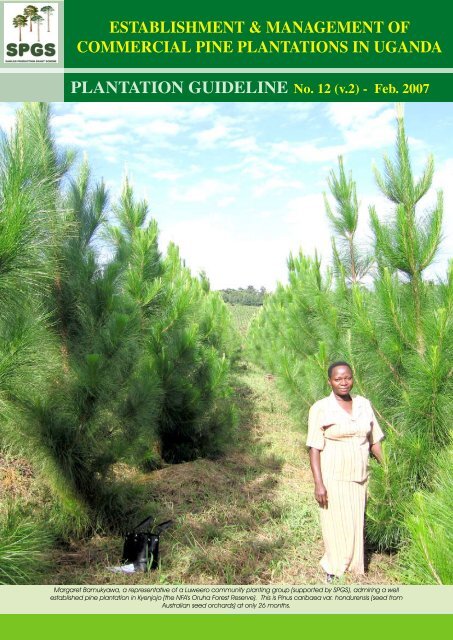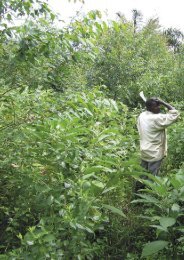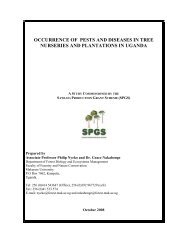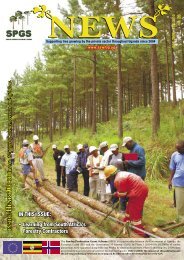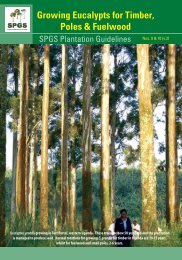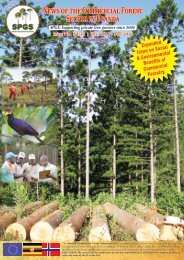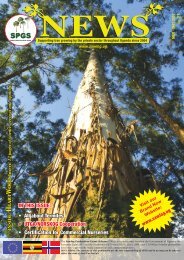Guideline No.12 - Gr.. - SPGS
Guideline No.12 - Gr.. - SPGS
Guideline No.12 - Gr.. - SPGS
Create successful ePaper yourself
Turn your PDF publications into a flip-book with our unique Google optimized e-Paper software.
PLANTATIONESTABLISHMENTGUIDELINES& MANAGEMENT OFCOMMERCIAL NO.18 (V.2) – PINE OCT. PLANTATIONS 2005 IN UGANDAN 18 J 2005PLANTATION GUIDELINE No. 12 (v.2) - Feb. 2007FIRE PROTECTIONe investment ofs must be takenate sector startplantations intion, the goldenfire control, them fast and keeporest safer are:es – not againstangers of foresttry to minimizedriest periods.STEM‣ Purchase and maintain suitable fire fightingequipment.‣ Ensure that any fires are spotted early and that thereare people on standby at critical times.‣ Train staff (including contractors) to ensure thatthey can fight fires efficiently and safely.‣ Use the Fire Danger Index system to guide levels ofpreparedness (see table below).‣ Follow-up immediately after fires: ensure lessonsare learned and take any disciplinary (or legal)action required.This <strong>Guideline</strong> will expand on all these points. Theadvice is based on practices developed to a fine art inSouthern Africa – where the plantation fire risk can beextremely high during the long, hot dry periodsexperienced there.REEN YELLOW ORANGE RED1-45 46-60 61-75 76-100ODERATE DANGEROUS VERYEXTREMELYDANGEROUS DANGEROUS-1.2 1.2-1.8 1.8-2.4 2.4+nly lighturface firesikely.lthoughontrolledurningperations cane doneithoutreating a fireazard, careust be takenhen burningn exposed, drylopes. Keep aDirect attackneeded if firesstart: moderatemopping upneeded.Extremecaution shouldbe taken whencontrolledburning iscarried out.Spread of firescan be fast:control andmopping updifficultNo controlledburning of anynature shouldoccur. Carefulnote should betaken of anysign of smoke –especially on theup-wind side ofany plantation.Any fire thatFires will bevery hot andspread veryfast.All personneland equipmentshould beremoved fromfield. Fireteams, labourand equipmentare to be placedon full stand-by.At the first signof smoke, everypossibleMargaret Bamukyawa, a representative of a Luweero community planting group (supported by <strong>SPGS</strong>), admiring a wellestablished pine plantation in Kyenjojo (the NFA’s Oruha Forest Reserve). This is Pinus caribaea var. hondurensis (seed fromAustralian seed orchards) at only 26 months.
1. Why Pine?Pines are generally better suited than most othercommercial tree species, to the grassland anddegraded woodland sites that are mostly availablefor plantation development in Uganda. Many ofthese sites experience hot, dry periods and somehave fairly poor soil. Pines can tolerate suchconditions, provided there is sufficient rootingdepth and moisture in the soil. Some pines (e.g. P.caribaea) have proved to be very adaptable to anumber of sites and soils.Pines are generally well suited to growing in theplantation situation. On good sites, some pinespecies (especially Pinus caribaea var. hondurensis- hereafter referred to as PCH) can grow very fast(e.g. mean annual increments exceeding 30m 3 /ha/yr in Uganda). Most pines also produce a veryversatile, general-purpose timber, which is nowwidely accepted by timber buyers and the Ugandanpublic.In certain areas in Uganda – particularly the bettersites with deep soil and high rainfall – growers couldconsider planting other species for timber (or pole)production: for example, Eucalyptus grandis (whichwill produce timber in considerably less time thanpines); Musizi (Maesopsis eminii) and Hoop Pine(Araucaria cunninghammii). For more informationrefer to the <strong>SPGS</strong> Plantation <strong>Guideline</strong>s No. 5 – TreeSpecies for Commercial Timber Production inUganda and No.9/10 (v.2) – <strong>Gr</strong>owing Eucalypts forTimber, Poles and Fuelwood.2. Pine Species for UgandaThe main pine species for plantations in Uganda arePCH, Pinus oocarpa and Pinus patula. P. patula iseasily identified from the drooping habit of its foliage– hence, its common name of weeping pine. It isnot so easy to tell PCH from P. oocarpa, however,although generally PCH bears its needles in groups(fascicles) of 3, whereas P. oocarpa usually has its ingroups of 5 (be warned though, each species canhave fascicles of 2, 4 or 5!). Young P. oocarpa treesoften appear very bushy for a while after plantingout, with branches sprouting from very low down ontheir stems: this characteristic, however, enables thetrees to re-sprout (coppice) if the plantation getsburnt.Other species have been tried in Uganda but havenot performed well – including, P. radiata and P.kesiya. Other pine species may become availablefor commercial planting in the future – e.g. naturallyoccurring hybrids between PCH and P. oocarpa(which have shown promising ‘hybrid vigour’ in Brazil)and also an artificial cross between PCH and P.elliottii (very successful in Queensland); P. caribaeavar. bahamensis, and better provenances (i.e. seedsources) of P. tecunumanii and P. kesiya – but theseneed to be first planted on a trial basis before wecan confidently recommend them for Uganda’sconditions.3. Species-Site MatchingP. caribaea var. hondurensis (PCH) is a lowlandtropical pine found naturally in Central Americanand the Caribbean basin. In its natural environment,PCH grows best at low altitudes (from sea levelto ca.700m) and on fertile, well drained sites withMean Annual Rainfall (MAR) of 2-3,000mm.PCH - Pinus caribaea var. hondurensis - is by far thepine suited to most sites in Uganda but only useimproved seed – which for many years will haveto be imported.PCH has been extensively planted throughout theAmerican, Asian and African tropics and subtropics,with substantial plantations in Australia, Fiji, Brazil,Venezuala, China and Vietnam. PCH is the mostproductive of the three varieties of P. caribaea (theothers being var. bahamensis and var. caribaea).PCH requires a tropical and humid climate, withMean Annual Rainfall (MAR) of over 1500mm foroptimum growth. PCH can resist moderate droughtsbut shallow soils and very hot, dry sites should beavoided. It grows on wide variety of soil types butrequires a well-drained soil (and at least 600mmrooting depth) for good growth. In Uganda, it growsup at altitudes up to 1500m but prefers the loweraltitudes.P. oocarpa occurs naturally in Mexico and CentralAmerica from 350 to 2500m altitude and with MARof 1000 to 1500mm. As a consequence of its widenatural distribution, P. oocarpa is a very variablespecies, which means that great care has to betaken when introducing it to other countries – ascan be seen from the poor performance of theGood plantation establishment is a combination of careful planning andtiming of silvicultural operations. Follow the recommendations in this<strong>Guideline</strong> to maximize yields and the returns on your investment.
species, particularly in their establishment phase.Pine plantations in Uganda only close their canopiesafter around three years, which has consequencesfor planning silvicultural operations – especiallyweeding. The adoption of the best silviculturalpractices, however, not only speeds up the onset ofcanopy closure but also ensures the highest yieldspossible on the site are obtained. These practicesare a combination of techniques – namely:Fidel Begumisa, a private planter in Kabale (SW Uganda) in his2-yr old Pinus patula stand (established with <strong>SPGS</strong> support). P.patula only grows well in the cool highland areas of Uganda.species in some Ugandan plantings. P. oocarpa isgenerally less productive than P. caribaea, havingslower initial growth and poorer wind-firmness,making it less desirable than PCH. Its lighter crownencourages a weedy under-storey to develop too,which increases the fire risk in plantations.In Uganda, P. oocarpa has traditionally beenrecommended over P. caribaea for higher altitudesites (>1200m) and also sites prone to periodicflooding. Such wet sites should generally be avoidedfor commercial tree planting with any species:additionally the poor form of the locally collected P.oocarpa compared with the improved PCH leadsus to recommend PCH on most other plantingsites. It is hoped to obtain better provenances (i.e.seed origins) of P. oocarpa (and its closely relatedspecies – P. tecunumanii) in the near future but it willobviously a number of years before results from anytrial plantings bear fruit.P. patula is the main commercial timber (and pulp)species in Southern African plantations.P. patula is frequently planted off-site (at lowaltitudes) in Uganda.It is only suited to cooler, moist areas in thesouth-west of Uganda.In Uganda, it is frequently being planted ‘off-site’ (i.e.on sites where it is not adapted to). When plantedon low altitude, hot sites, P. patula does not performwell: it requires high altitude, with a cool and moistclimate. The only region which meets the species’requirements in Uganda, are the highlands in theSouth-West (Kabale).Further details can be found in <strong>SPGS</strong> Plantation<strong>Guideline</strong> No. 6 – Site Species Matching for Uganda’sMain Commercial Tree Species.4. Planning IssuesEven the tropical and sub-tropical pines cultivated inUganda generally grow slower than most Eucalyptus‣ Use of improved seed (preferably seedorchard);‣ good land preparation;‣ timely weed control to minimise competition,especially in the first few years and‣ thinning at the recommended times.NB. Pruning is also recommended but is a qualityissue not directly affecting the plantation yield.The expected rotation for pines grown in Uganda,ranges from 18-25 years. It is feasible for sawlogsto be produced earlier – from thinning operationsat maybe 8-10 years and final crops from 15 yearsonwards – but only on productive sites where heavy,early thinnings have been carried out. With theimbalance in supply and demand predicted forUganda, the actual rotation will undoubtedly bedetermined more by market forces than silviculturalones.An example of good pine (PCH) establishment at the Kasana-Kasambyademonstration plot, near Mubende. This 12 month old crop illustratesappropriate spacing, use of good seed and seedlings, planting at theright time and especially good weeding.The cost for establishing commercial pineplantations in Uganda has been estimated by the<strong>SPGS</strong> to be around Ushs1.2M per hectare: this is anaverage cost across a range of sites in the country.The costs can vary depending on a range of factorsbut especially the optimum timing of operations,the techniques employed for land clearance and US$ 676 at Feb. 2007 exchange rate of 1US$= Ushs1775.
weed control and the experience of the workforce(both basic labour and supervisory levels). Forfurther information refer to <strong>SPGS</strong> <strong>Guideline</strong>s: No. 3– Planning for Successful Plantation Developmentand No. 4 – Productivity & Costs of PlantationDevelopment in Uganda.5. StockingThe traditional stocking for pines in many tropicaland sub-tropical countries has been 9’x9’, whichequates approximately to 2.7m x 2.7m (or 1372 sph ).Assuming you are using improved seed, goodquality seedlings and have good standards ofland preparation (as detailed in this <strong>Guideline</strong>), itis recommended to plant PCH at a spacing of 3x 3m (1111 sph). Until improved seed is availablehere, however, the recommended spacing forboth P. oocarpa and P. patula is 2.7 x 2.7m (1372sph), which allows more selection from the crop atthinning stage.6. Its All In The Genes: Seed & Seedling SourcesAs emphasised throughout these Plantation<strong>Guideline</strong>s, the seed source is critical to the successof your plantation. The pictures on page 6 shouldspeak for themselves and illustrate why the <strong>SPGS</strong>only recommends using improved, imported pineseed.Most of the originalpine stands in Ugandawere established fromunselected seed fromnatural stands in CentralAmerica and many trialsaround the world haveshown that PCH has anotoriously poor formin its unimproved state.Virtually all the Ugandanplantations have sincebeen felled anyway,and those that remainare not good enough tocollect seed from. It isalso true that in a numberof the older P. caribaea stands in Uganda, seedproduction has generally been poor: the reasons forthis are uncertain but similar observations have beenreported from South Africa, Malawi and Zimbabwe,Planting at 1111 sph compared with 1372 sphrepresents almost a 20% saving in plant costs and inthe labour intensive preparation of pits.sph = stems per hectare.where poor seed availability has restricted thespecies’ commercial planting over the last 20 yearsor so.The consequence of having no locally produced,improved PCH seed means that for many years,Uganda will have to continue importing seed tomeet its needs. To meet this demand for PCH seed,seed is being imported from the only countries withPCH breeding programmes – namely, Australia,South Africa and (since 2005) from Brazil. Thissituation will only be resolved when Uganda has itsown pine breeding programme bearing fruits andto date this has not even started.Australia: Forest Plantations Queensland (FPQ) inAustralia, has established over 50,000 ha of PCHplantations (and a further 44,000 ha of a hybridbetween P. elliottii and PCH). To support this majorplantation development, FPQ have been involvedin intensive breeding programme with PCH and it isseed from their advanced generation, clonal seedorchards which has been imported into Ugandasince 2002. The parent trees in these seed orchardshave been selected for their fast growth, resistanceto pests and diseases, and their superior stem formand branching characteristics (see photo). PCH hasformed the basis of an extensive pine breedingprogramme by Forest Plantations Queensland (FPQ)in Australia, for over 50 years.One of (FPQ’s (Forest Plantations Queensland) clonal PCH seedorchards in Australia – the source of much of Uganda’s pineseed since 2003.The quality of this FPQ seed is clear to see fromthe earliest plantings carried out by the FRMCP in 2002/03 in demonstration plantings aroundUganda. Prior to 2006, known as the Dept. of Primary Industries (DPI). The EC-funded Forest Resources Management & ConservationProgramme (2002-2006) – was the parent programme of the 1 stphase of the <strong>SPGS</strong>.
With the major expansion into commercial forestrysince 2003 (by both the private sector under the <strong>SPGS</strong>and the National Forestry Authority), the demand forthe FPQ PCH seed has quickly outstripped supply.Following a visit by <strong>SPGS</strong> staff in mid-2006, however,more seed has been made available to Ugandabut the supply still falls way short of total demand.South Africa: in South Africa, PCH was planted inlowland sites near the coast but the species has nowgone out of favour due to its low-density wood, whichdoes not compare well with alternative species foreither pulp or solid wood products. South Africaalso started a breeding programme with PCH andalthough they hardly plant the species now, theyhave maintained their seed orchards: althoughvery limited in quantity, Uganda imports seed fromthese orchards when available.Brazil: With rapidly increased demand in 2005,FPQ could not supply Uganda’s needs and so effortswere made to find suppliers of other improved PCHseed sources. Following a recommendation fromCAMCORE , a reputable supplier from Brazil’s SãoPaolo state – Schuckar Seeds – was contacted. Schuckarhave seedproduction standsof PCH (and otherpines) and seedfrom these hasThe cone of Pinus oocarpa.been importedinto Uganda since2005. NB. Whilst theearly performanceof the BrazilianPCH seed isgenerally good,its germination is significantly less than the Australian seed(refer table) so more has to be sown to get the requirednumber of seedlings.The table shows the seed origins are currentlyrecommended for Pines in Uganda:Contact the National Tree Seed Centre’s Manageron 0772 561 227. The <strong>SPGS</strong> works closely with theNTSC regarding importing seed: see the regular SeedUpdate page in the <strong>SPGS</strong>’s bimonthly Newsletter.7. Nursery MattersAnyone starting planting pine (or other commercialspecies) on a significant scale now in Uganda, hasa choice: either start your own nursery or order theseedlings from a larger, external nursery. Standardsin many of the small nurseries around the countryare generally poor and many commercial treeplanters in Uganda are now seeing the benefits ofsourcing seedlings from one of the larger, improvednurseries rather than setting up their own nurseries. CAMCORE – the Central American & MexicanConiferous Resources Cooperative.The NFA’s nursery at Namanve, nr. Kampala: one of the <strong>SPGS</strong> recommendednurseries for supplying tree seedlings. Seed source must always be clearlyspecified when ordering seedlings<strong>SPGS</strong>-Recommended Seed Sources for Commercial Planting in UgandaSpecies Seed Source Viable Seeds* Approx. PricePer kgUshs/kgPCHFPQ’s Clonal Seed Orchards inQueensland, Australia35,000 2,000,000- ditto - South African Seed Orchards 30,000 850,000- ditto - Seed production stands, Brazil 25,000 850,000P. oocarpa Seed production stands, Brazil 25,000 850,000P. patula † ‘Plus’ tree selections in Uganda 60,000 500,000others Trial basis only ‡ . - -* Always check with the supplier the germination ofeach batch of seed and adjust order/sowing accordingly.† Efforts will be made in 2007 to also import seed orchardP. patula seed from South Africa.‡ See the <strong>SPGS</strong> Newsletter for latest information on treeseed.
1How not togrow pines321 A natural population of PCH trial in Queensland, Australia, showing poorform: very similar to Uganda’s initial importation of PCH seed and this iswhy the <strong>SPGS</strong> only recommends using improved seed.2 Locally collected (unimproved) pine seed was used for this poorplantation near Jinja. With no tree improvement programme yet inplace, Uganda will have to rely on imported, improved pine seed formany years.3 An all too common sight: planting a weak pine seedling into a veryweedy site. This seedling will struggle and grow slowly: not the way toestablish fast growing, high yielding plantations!4 Another example of poor pine silviculture: poor seed (locally collected)and enormous weed competition. The result is predictable: highvariability, low stocking and very poor growth..5 The use of taungya (growing crops and trees together) has not workedin Uganda for the last 30 years. As this typical poor pine crop shows, thisis clearly not the way to establish commercial tree plantations.6 The consequences of poor silviculture and management are clear herein this over mature, stressed plantation at Katuugo Forest Rreserve. Poorseed, no thinning or pruning and no protection from seasonal fireshave taken their toll. The result is low yields and poor qualitysawlogs.465
1<strong>Gr</strong>owingpines: bestpractice24351 A well established, young PCH planting by Arthur Busingyein Kasiyo-Kitomi Forest Reserve, Bushenyi. A combination ofgood seed, quality seedlings, good land preparation andweeding has given this crop a good start.2 An excellent 12-month old PCH crop at the NFA’s OruhaForest Reserve, Kyenjojo. The benefits of pre-plant sprayingwith Glyphosate and good quality seedlings (ex-Australiaseed) are clear.3 Another good example of pine (PCH) establishment atRichard Bakojja’s planting at Kasana-Kasambya CFR, nearMubende.4 A mature pine crop in South Africa. Obviously wellestablished and good genetic stock: timely thinning andpruning operations have also then ensured that this is a highvalue stand.5 Good weeding is essential in the early phase of establishmentand also provides many rural jobs.6 Another excellent example of good establishment, this oneby Global Woods Ltd. at Kikonda CFR, near Hoima. This is1.5 yr old PCH from Australian seed. Weeding has beengood, both before and after planting.6
from the root collar). Reject over and undersizedplants and any that show signs of damageor sickness. Smaller seedlings may not have welldeveloped root systems needed to cope with theharsh conditions inevitably encountered followingplanting out. Larger seedlings will struggle to establishthemselves as the small root system tries to copewith the demands (of water and nutrients) from theleaves. For more information on tree nurseries inUganda refer to <strong>SPGS</strong> Plantation <strong>Guideline</strong> No. 7– Tree Nurseries: the Key Issues.The future? Hybrid pine cuttings at one of FPQ’s nurseries in Australia. These areselected Pinus elliottii x PCH crosses.Before you buy tree seed, always ask for itsfull origin and collection details as well as itsexpected germination %.Both the NFA and an increasing number of privatelyowned nurseries have improved over the last fewyears and many are now able to take orders tosupply seedlings to private growers. Orders must betaken 6 months in advance to allow for planning,seed purchase and time to raise the plants.Payment of a 30% deposit is recommended at thetime of order.Insist on seedlings from improved seed and thenonly plant healthy plants, 15-25cm tall (measured8. Site PreparationThe chosen method of land preparation will dependon the nature of the vegetation to be cleared andthe resources (labour, machinery etc.) availableto the grower. The most important issue with landpreparation is to time it so that the land is clear intime for subsequent operations – namely, lining out,pitting and pre-plant spraying operations. Clearingland too early will lead to heavy weed growth, whichwill have to be controlled prior to planting. Clearingtoo late leads to delays in planting: planting late inthe rainy season is always risky and usually ends infailure of the crop.Choose the most appropriate and cost-effectivemethod for land preparation. Piling and burningthe trash makes the site easier to mark out forplanting and also helps with subsequent weedingoperations. Lining out carefully also pays dividendsfor all subsequent work (and supervision of work).It is also important to prepare good planting pits sothat the young seedlings get the best start possible.Pits should be a minimum of 20cm in diameter,cultivated to a depth of 20cm. The pits shouldnot be prepared too long in advance of plantingotherwise the soil can compact again. For furtherdetails, refer <strong>SPGS</strong> Plantation <strong>Guideline</strong> No. 14 – LandPreparation.Excellent land preparation and weeding are evident here at Busoga Forest Co. Ltd’s 2006 PCH planting. High stocking anduniformity have been achieved to give this plantation the best possible start.
9. Pre-Plant Weeding See Section 13.10. Timing of PlantingThe same rule applies for all plantation species:namely, plant as early as possible in the rainyseason. This gives the young trees the maximumchance of establishing themselves well before theonset of the hot, dry period that follows each rainyseason in Uganda. Normal (‘dry’) planting canusually take place when >50mm of rain has beenreceived – but this depends on a number of sitespecificfactors and the site must be checked forsoil moisture down to at least 25mm depth beforedeciding to plant.Depending on the region (and the season), thebest times to plant are usually early in either of thetwo rainy seasons experienced in most of the mainplantation regions in Uganda (normally March/Apriland Sept/Oct). The use of super-absorbants (e.g.Aqua-Soil) can also extend the planting time.11. Beating Up Always plan to raise (or order) up to 15% extra plantsto replace the failures from the initial planting.Preferably within two weeks of the initial planting,carry out a quick survival check by counting thefailures in a sample number of lines. Generally if thesurvival is below 90% (i.e. over 10% deaths), blankingis recommended. In the blanking operation it isimportant to use the same seedling stock that wasused for the original planting. Late blanking andusing different seed stock from the original plantingare the main causes of variability in Ugandanplantations. For further details refer to <strong>SPGS</strong> Plantation<strong>Guideline</strong> No. 23 – Planting & Beating Up.Blanking in season following the initial plantingis not recommended except in exceptionalcircumstances, as it will inevitably lead tovariability in the plantation.12. FertilisingIt has generally not been common practise tofertilise pine crops in many tropical or sub-tropicalcountries. South African research, however, hasshown sustained response of pines to P (Phosphorus)applications on some sites. In Queensland, Australia,fertilisers have produced a very significant responsein conjunction with site cultivation but these are verypoor (infertile) sites compared to most of Uganda.Specific sites in Madagascar and Nigeria have also The term beating up refers to the replacementof failures: it is also known as infilling or blanking– depending on where you are from!A high quality PCH seedling (within the <strong>SPGS</strong> recommendedsize limits 15-25mm) just planted onto well prepared (andweeded) soil.shown good responses to fertiliser but it is highlydependent on the site’s nutrient status. At thisstage in Uganda, however, we do not recommendfertilising pines in Uganda, until research proves it tobe worthwhile.13. WeedingThere is no point wasting time and money onpreparing the planting site to a high standard,planting high quality seedlings and then neglectingweeding – and yet this is exactly what many treeplanters in Uganda are doing!As emphasised throughout this series of Plantation<strong>Guideline</strong>s, weed control starts well before planting.The aim is to control problem weeds beforeplanting and then to keep any subsequent weedsto a minimum. Where there is a predominanceof tough, perennial grasses and tall broadleavedweeds, for example, we recommend a pre-plantspray with Glyphosate, carefully timed to minimizethe period between spraying and planting.Following planting, a manual spot (or ring) weedis generally recommended for all pine species,to minimise competition and ensure good growthof the trees. The aim of this operation is to create
on weeding refer to <strong>SPGS</strong> Plantation <strong>Guideline</strong>s No.16 (v.3) – Safe Use of Glyphosate Herbicide; No. 15– Post-Plant Weed Control and No. 17 - Post-PlantUse of Glyphosate.14. TaungyaTaungya is the practice of establishing a tree cropin conjunction with an agricultural crop. It has beenused successfully in a number of countries but overthe past 30 years or so, the practice has failed toproduce commercial tree plantations in Uganda.Taungya has become an excuse for people toplant their food crops in Forest Reserves under thepretence of establishing tree crops, which somehownever materialise. Poor tree stocking, low yieldsand very bad stem form are the consequenceof employing taungya in Uganda. Consequently,taungya is not recommended for establishingtimber crops in Uganda (NB. the practice is notpermitted under the <strong>SPGS</strong> contracts).Spot weeding is the most important operation in the fewmonths after planting.a weed-free zone of 50cm radius around eachplanted seedling. This operation usually is carriedout with a sharp hoe. One common problem,however, is that the labourers hoe right up to thetree stem. After a number of passes, the tree canbecome unstable and easily fall over. It is thusrecommended to manually hand-pull any weedsin a zone 10cm radius around each tree.Following the initial spot weed, a row (or line) weedingis often recommended: a 1 m strip (500 mm eitherside of the seedlings) is recommended. A lineweedingoperation is easier to supervise – providedthe tree rows have been aligned well. Further detailsIt is better to completely separate the growing offood crops and timber trees in time and space.Clearing land ahead of planting and allowing localpeople to grow food crops for up to a year priorto planting trees can work but the trees must beplanted at the right time with no other crops there.For further details refer <strong>SPGS</strong> Plantation <strong>Guideline</strong>No. 24 – Taungya.16. ProtectionAlthough the tropical pines discussed in this <strong>Guideline</strong>are relatively fast growing, rotations may still exceed20 years (see Section 4) and a lot can happen toa plantation in that time. The plantation will haveto protected throughout its life from damage fromanimals, fires and pests and diseases that maycome along. Protection need not be expensive butit must be carried out on time and regularly.Refer to the following <strong>SPGS</strong> Plantation <strong>Guideline</strong>s formore information:‣ No. 18 – Fire Protection.‣ No. 19 – Common Pests & Diseases of TreePlantations.‣ No. 20 – Protecting Tree Plantations FromAnimals.17. FoxtailingThe phenomenon known as foxtailing (see photo)sometimes occurs in pine plantations in tropicalcountries – including Uganda. Foxtailing is a strikingform of apical dominance, which can lead to stemsof over 10 metres with no branches. Foxtailed treesare unstable and will often break in the wind. Thecauses of foxtailing are only partly understood.10
Suggested Thinning Regime for Pine Sawtimberin UgandaThinNo.AgeFrom(sph)To(sph)1 4-6 1111* 7502 6-9 750 5003 9-12 500 300Fell 18-25 300* assumes initial planting at 3x3m.The timing (and number) of thinning operationsdepends largely on the growth rate of a particularspecies on a site and the objectives of the grower(e.g. specific market specifications for products).The thinning intensity is obviously linked to the initialstocking (sph). A suggested thinning regime forexpected growth rates of pine on an average site inUganda is outlined in the Table (above). It is worthnoting that one of the most common mistakes madeby commercial tree growers is their reluctance tothin either on time or to the intensity that will reallymaximise the benefit to the remaining crop.Early and heavy thinnings are stronglyrecommended - to produce largediameter trees as fast as possible.The consequences of poor silviculture and management are clear here inthis over mature, stressed plantation at Katuugo Forest Rreserve. Poor seed,no thinning or pruning and no protection from seasonal fires have taken theirtoll. The result is low yields and poor quality sawlogs.Foxtailing is known to be an inherited characteristicbut it is also related to site and climatic conditions.There is increased incidence of foxtails on tropicallowland sites with consistently high temperatures,deep fertile soils and heavy, non-seasonal rainfall.Since foxtails are undesirable, they should beremoved in the first thinning operation (see nextsection).18. ThinningIf you want to produce the maximum yield oflarge sawlogs, thinning is an absolutely essentialoperation. Early, heavy thinnings, to remove poorquality trees and also to promote fast diametergrowth are recommended. For the crop to developto its maximum potential, the thinning operationsmust be carried out at the appropriate time. Late(or no) thinning results in a crop of many small stemsand an unhealthy crop as competition sets in.Each thinning operation obviously yields sometrees, though from the early (first) thinning, they willbe small (and some misshapen). As the tree sizeincreases with age, so the 2 nd and 3 rd thinnings willproduce smaller sawlogs. This should provide someuseful income to the grower, prior to the main sale ofhigh quality sawlogs at rotation age. Refer to <strong>SPGS</strong>Plantation <strong>Guideline</strong> No. 26 – Thinning Plantationsfor Timber Production – for further details.19. PruningPruning of Pine trees is recommended for thefollowing main reasons:‣ To improve timber quality (to produce cleartimber, to prevent the formation of dead (loose)knots and to reduce the size of live (sound)knots).‣ To facilitate access into the plantation (forthinning, fires and observing pests anddiseases).Clear, knot-free timber is laid down in the yearsfollowing pruning thus it is important to time theoperation well to maximise its effect. It is also a costly(labour intensive) operation and if done incorrectly,11
This excellent pine (P. elliottii) plantation in Swaziland (Shiselweni forest Co. ) will produce high quality, large sawlogs. the key isthe use of improved (seed orchard) seed and timely thinnings.can do more harm than good. Removal (bypruning) of up to 25% of the live crown will not affectincrement significantly: the best rule to remember,however, is to never prune more than half the totaltree height. Pruning is usually carried out in 3 or 4successive stages as the trees grow in height. Forfurther details, refer to <strong>SPGS</strong> Plantation <strong>Guideline</strong> No.27 – Pruning for High Quality Timber.20. YieldsIt is difficult to predict the expected growth rate ofpines in Uganda. There are two main reasons for this:firstly, the older pine plantations in Uganda were notthinned and secondly, the silvicultural techniquesrecommended throughout this (and other) <strong>SPGS</strong>Plantation <strong>Guideline</strong>s, have not been in placehere before (e.g. the use of improved seed andmore intense land preparation and weed controlmethods). We can make predictions, however,based on experience with similar crops elsewhere.Assuming that the pine plantations have been wellestablished, the correct species has been planted,the crop has been well maintained (especiallyprotected from fires) and thinned on time, thefollowing yields are predicted:‣ PCH: Mean Annual Increments (MAI) of 25-35m 3 /ha/yr.‣ P. oocarpa: MAI 20-30m 3 /ha/yr.‣ P. patula: MAI 25-35m 3 /ha/yr.Thus, at 20 years old, PCH might be expected toproduce 500-700m 3 per ha (total volume includingwhat is removed in thinning operations). Butremember - these high growth rates will only beachieved by following closely the recommendationsmade in this <strong>Guideline</strong>, particularly with regard toseed source, seedling quality, site selection, goodland preparation, weeding before and after plantingand then thinning to the correct stocking on time.It is hoped that this <strong>Guideline</strong> may sow the seeds for the establishment of asubstantial and good quality pine plantation resource in Uganda.Please send any feedback on content to the <strong>SPGS</strong> - info@sawlog.ug<strong>SPGS</strong> Contact Details:Plot 92 Luthuli Avenue Bugolobi, KampalaEmail: info@sawlog.ug, Tel: 0312 265 332/3, Website: www.sawlog.ug12


